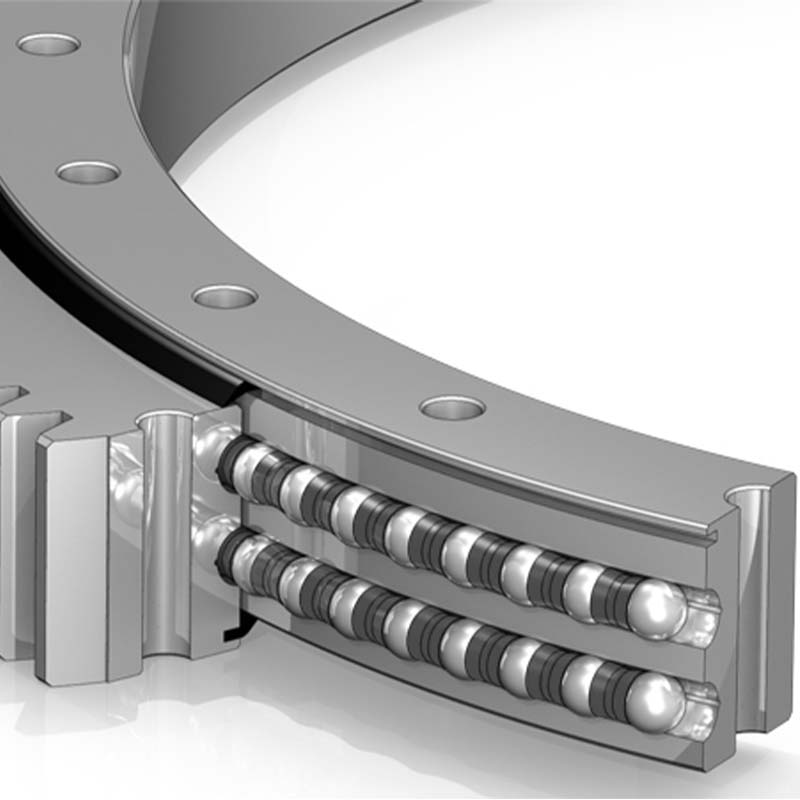A Double Row Ball Slewing Ring Bearing is a specialized type of bearing that is designed to handle simultaneously occurring axial, radial, and moment loads with high efficiency and precision. This bearing type features two rows of rolling elements, typically balls, which allow it to support greater loads than single-row configurations. It is particularly well-suited for applications requiring medium to high rotational speeds and where precision is important.
Double Row 8 Point Contact Ball Slew Bearings
The double-row ball slewing bearing is mainly composed of an inner ring, an outer ring, two rows of rolling elements (steel balls), a spacer or a cage and a sealing device.
Read More Get A Quote
Features of Double Row Ball Slewing Ring Bearings
Two Rows of Balls: These bearings have two separate rows of balls which can be designed to bear loads independently, enhancing the load capacity and stability of the bearing.
Different Ball Diameters: Often, the rows will use balls of different diameters to optimize load distribution and maximize the contact area, improving the bearing's load capacity.
Raceway Design: The raceways are typically machined into both the inner and outer rings, which are matched to the ball size and load specifications. This design helps in evenly distributing the load across the bearing.
Integral Gearing: Double row ball slewing bearings can be manufactured with internal or external gears, or without gears, depending on the application needs. Gearing allows the bearing to act as a drive mechanism in addition to a load-bearing component.
Sealing System: High-quality seals are used to protect the bearing internals from contaminants and moisture, crucial for maintaining performance and longevity in harsh environments.
Spacer or Cage: A spacer or cage can be used between the balls in each row to maintain uniform spacing and reduce friction and wear.
Advantages of Double Row Ball Slewing Ring Bearings
Increased Load Capacity: The double row design allows these bearings to handle significantly more load in both axial and radial directions compared to single-row bearings.
Better Stability and Stiffness: With two rows of balls, these bearings provide better stability and increased stiffness, which is beneficial for applications involving complex loads.
Compact Design: Despite the increased load capacity, these bearings maintain a relatively compact profile, which is valuable in applications with limited space.
Versatility: They can be adapted to a wide range of applications by modifying the type and size of balls, the material of the rings, and the type of seals used.
High Rotational Accuracy: Provides smooth rotation and high precision, which is essential for applications such as precision machinery and robotics.
Common Applications of Double Row Ball Slewing Ring Bearing
Cranes and Lifts: Used in the rotating parts of tower cranes, mobile cranes, and boom lifts to support heavy loads while providing smooth rotation.
Wind Turbines: Applied in the yaw and pitch bearing mechanisms to control the orientation of the turbine blades and nacelle.
Medical Equipment: Utilized in rotating tables for CT scanners and MRI machines, where precision and reliability are critical.
Rotary Tables and Manipulators: Common in manufacturing and robotic applications where both load-bearing and rotational movement are required.
Marine Applications: Used in shipboard cranes, davits, and other marine handling systems where robustness and corrosion resistance are needed.
How to select Double Row Ball Slewing Ring Bearing?
Load Characteristics: Understanding the specific load characteristics (axial, radial, and moment loads) is crucial for selecting the right bearing size and specifications.
Environmental Conditions: The operating environment's impact on material selection and sealing solutions must be considered to ensure durability and operational integrity.
Service Life and Maintenance: Considerations for service life, maintenance intervals, and ease of maintenance can affect the design and material choices.
Customization Needs: Depending on the application, customization in terms of dimensions, materials, gearing options, and sealing systems may be necessary.




